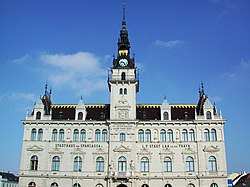Laa an der Thaya
| Laa an der Thaya | ||
|---|---|---|

Town hall
|
||
|
||
| Location within Austria | ||
| Coordinates: 48°43′N 16°23′E / 48.717°N 16.383°ECoordinates: 48°43′N 16°23′E / 48.717°N 16.383°E | ||
| Country | Austria | |
| State | Lower Austria | |
| District | Mistelbach | |
| Government | ||
| • Mayor | Brigitte Ribisch (ÖVP) | |
| Area | ||
| • Total | 72.89 km2 (28.14 sq mi) | |
| Elevation | 183 m (600 ft) | |
| Population (1 January 2016) | ||
| • Total | 6,224 | |
| • Density | 85/km2 (220/sq mi) | |
| Time zone | CET (UTC+1) | |
| • Summer (DST) | CEST (UTC+2) | |
| Postal code | 2136 | |
| Area code | 02522 | |
| Website | www.laa.at | |
Laa an der Thaya is a town in the Mistelbach District of Lower Austria in Austria, near the Czech border. The population in 2016 was 6224.
The town is located in the northern Weinviertel region, near the Thaya river, directly at the border with South Moravia. The municipal area includes the cadastral communities of Hanfthal, Kottingneusiedl, Pernhofen, Ungerndorf, and Wulzeshofen.
A settlement at a ford across the Thaya existed already in the 12th century, before the estates were acquired by the Babenberg dukes of Austria about 1190. Duke Leopold VI of Austria about 1230 had the walled town of Laa laid out as a strategic outpost at the border with the Kingdom of Bohemia in the north. His successor Duke Frederick the Warlike used it as a military base for his Bohemian campaigns, until he was finally killed in battle in 1246. The erection of the St Vitus parish church was begun about 1240, it is today one of the largest preserved Romanesque church buildings in Lower Austria.
Laa's town privileges were confirmed when the Austrian lands had passed to King Ottokar II of Bohemia, and again in 1281 by the Habsburg ruler King Rudolph I of Germany after his victory in the Battle on the Marchfeld. Nevertheless, the town's significance decreased over the following decades, it was devastetad by the troops of Margrave Jobst of Moravia in 1407 and again in 1426 by Hussite forces. According to legend, the later Pope Pius II (Enea Silvio Piccolomini) worked as a priest at the Laa parish church from 1442, actually he served as papal legate to the Imperial Diet and counsellor of Emperor Frederick III. To improve Laa's economy, the citizens were granted the privilege of brewing in 1454.
...
Wikipedia


